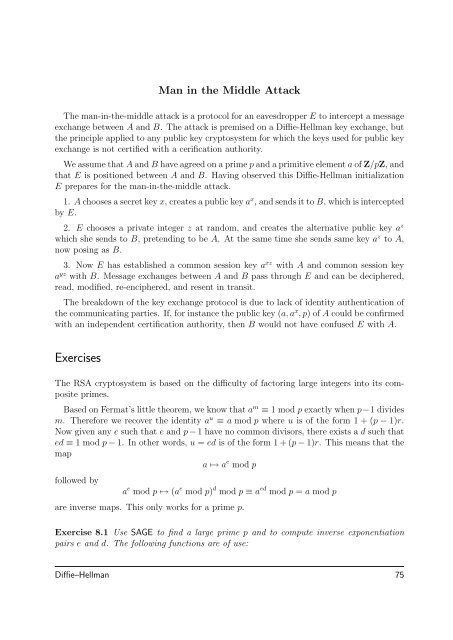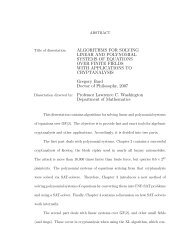Man in the Middle AttackThe man-in-the-middle attack is a protocol for an eavesdropper E to intercept a messageexchange between A and B. The attack is premised on a Diffie-Hellman key exchange, butthe principle applied to any public key cryptosystem for which the keys used for public keyexchange is not certified with a cerification authority.We assume that A and B have agreed on a prime p and a primitive element a of Z/pZ, andthat E is positioned between A and B. Having observed this Diffie-Hellman initializationE prepares for the man-in-the-middle attack.1. A chooses a secret key x, creates a public key a x , and sends it to B, which is interceptedby E.2. E chooses a private integer z at random, and creates the alternative public key a zwhich she sends to B, pretending to be A. At the same time she sends same key a z to A,now posing as B.3. Now E has established a common session key a xz with A and common session keya yz with B. Message exchanges between A and B pass through E and can be deciphered,read, modified, re-enciphered, and resent in transit.The breakdown of the key exchange protocol is due to lack of identity authentication ofthe communicating parties. If, for instance the public key (a, a x , p) of A could be confirmedwith an independent certification authority, then B would not have confused E with A.ExercisesThe RSA cryptosystem is based on the difficulty of factoring large integers into its compositeprimes.Based on Fermat’s little theorem, we know that a m ≡ 1 mod p exactly when p−1 dividesm. Therefore we recover the identity a u ≡ a mod p where u is of the form 1 + (p − 1)r.Now given any e such that e and p − 1 have no common divisors, there exists a d such thated ≡ 1 mod p − 1. In other words, u = ed is of the form 1 + (p − 1)r. This means that themapa ↦→ a e mod pfollowed bya e mod p ↦→ (a e mod p) d mod p ≡ a ed mod p = a mod pare inverse maps. This only works for a prime p.Exercise 8.1 Use SAGE to find a large prime p and to compute inverse exponentiationpairs e and d. The following functions are of use:Diffie–Hellman 75
andom prime, gcd, xgcd, and inverse mod.The RSA cryptosystem is based on the fact that for primes p and q and any integer e withno common factors with p − 1 and q − 1, it is possible to find an d 1 such thated 1 ≡ 1 mod (p − 1),ed 2 ≡ 1 mod (q − 1).Using the Chinese remainder theorem, it is possible to then find the unique d such thatd = d 1 mod (p − 1) and d = d 2 mod (q − 1)in the range 1 ≤ d < (p − 1)(q − 1). This d has the property thata ed ≡ a mod n.The send a message securely, the public key (e, n) is used. First we encoding the message asan integer a mod n, then form the ciphertext a e mod n. The recipient recovers the messageusing the secret exponent d.Exercise 8.2 Use your exponents e, d, verify the identities mod p:for various random values of a.(a e ) d ≡ a mod n, (a d ) e ≡ a mod n, and a ed ≡ a mod n,Note that after construction of d, the primes p and q are not needed, but that withoutknowing the original factorization of n, Fermat’s little theorem does not apply, and findingthe inverse exponent for e is considered a hard problem.Exercise 8.3 Use the above factorization to reproduce the private key L (generated but notprinted above) for this K.Exercise 8.4 Why is the choice for which key is the public key and which key is theprivate key arbitrary? Practice encoding, decoding, enciphering, and deciphering with theRSA cryptosystem. Why do the member functions enciphering and deciphering returnthe same values?An ElGamal cryptosystem is based on the difficulty of the Diffie–Hellman problem:Given a prime p, a primitive element a of (Z/pZ) ∗ = {c ∈ Z/pZ : c ≠ 0}, and elementsc 1 = a x and c 2 = a y , find the element a xy in (Z/pZ) ∗ .Exercise 8.5 Recall the discrete logarithm problem: Given a prime p, a primitive elementa of (Z/pZ) ∗ , and an element c of (Z/pZ) ∗ , find an integer x such that c = a x . Explainhow a general solution to the discrete logarithm problem for p and a implies a solution tothe Diffie–Hellman problem.76 Chapter 8. Public Key <strong>Cryptography</strong>
- Page 1 and 2:
Author (David R. Kohel) /Title (Cry
- Page 4 and 5:
CONTENTS1 Introduction to Cryptogra
- Page 6:
PrefaceWhen embarking on a project
- Page 10 and 11:
information. We introduce here some
- Page 12 and 13:
ut strings in A ∗ map injectively
- Page 14 and 15:
CHAPTERTWOClassical Cryptography2.1
- Page 16 and 17:
LV MJ CW XP QO IG EZ NB YH UA DS RK
- Page 18 and 19:
As a special case, consider 2-chara
- Page 20 and 21:
Note that if d k = 1, then we omit
- Page 22:
ExercisesSubstitution ciphersExerci
- Page 25 and 26:
Ciphertext-only AttackThe cryptanal
- Page 27 and 28:
of size n, suppose that p i is the
- Page 29 and 30: Note that ZKZ and KZA are substring
- Page 31: Checking possible keys, the partial
- Page 34 and 35: sage: X = pt.frequency_distribution
- Page 36 and 37: CHAPTERFOURInformation TheoryInform
- Page 38 and 39: For each of these we can extend our
- Page 40 and 41: in terms of the cryptosystem), then
- Page 42 and 43: CHAPTERFIVEBlock CiphersData Encryp
- Page 44 and 45: Deciphering. Suppose we begin with
- Page 46 and 47: The Advanced Encryption Standard al
- Page 48 and 49: 1. Malicious substitution of a ciph
- Page 50 and 51: locks M j−1 , . . . , M 1 as well
- Page 52: where X = K ⊕ M = (X 1 , X 2 , X
- Page 55 and 56: 6.2 Properties of Stream CiphersSyn
- Page 57 and 58: Exercise. Verify that the equality
- Page 59 and 60: n 2 n − 11 12 33 74 155 316 637 1
- Page 61 and 62: Exercise 6.6 In the previous exerci
- Page 63 and 64: Exercise 6.9 Compute the first 8 te
- Page 65 and 66: which holds since −4 = 17 + (−1
- Page 67 and 68: must therefore have a divisor of de
- Page 69 and 70: Shrinking Generator cryptosystemLet
- Page 72 and 73: CHAPTEREIGHTPublic Key Cryptography
- Page 74 and 75: Initial setup:1. Alice and Bob publ
- Page 76 and 77: We apply this rule in the RSA algor
- Page 78 and 79: the discrete logarithm problem (DLP
- Page 82: Exercise 8.6 Fermat’s little theo
- Page 85 and 86: k < p − 1 with GCD(k, p − 1) =
- Page 88 and 89: CHAPTERTENSecret SharingA secret sh
- Page 90: using any t shares (x 1 , y 1 ), .
- Page 93 and 94: sage-------------------------------
- Page 95 and 96: sage: x.is_unit?Type:builtin_functi
- Page 97 and 98: Python (hence SAGE) has useful data
- Page 99 and 100: sage: n = 12sage: for i in range(n)
- Page 101 and 102: sage: I = [55+i for i in range(3)]
- Page 103 and 104: sage: I = [7, 4, 11, 11, 14, 22, 14
- Page 105 and 106: ExercisesRead over the above SAGE t
- Page 107 and 108: 102
- Page 109 and 110: Solution. The block length is the n
- Page 111 and 112: Solution.below.The coincidence inde
- Page 113 and 114: analysis of the each of the decimat
- Page 115 and 116: arbitrary permutation of the alphab
- Page 117 and 118: In order to understand naturally oc
- Page 119 and 120: We do this by first verifying the e
- Page 121 and 122: Solution.None provided.Linear feedb
- Page 123 and 124: Multiplying each through by the con
- Page 125 and 126: Solution. The linear complexity of
- Page 127 and 128: If a, b, and c are as above, then f
- Page 129 and 130: Exercise 8.5 Use SAGE to find a lar
- Page 131 and 132:
Solution. Now we can verify that e
- Page 133 and 134:
which has no common factors with p
- Page 135 and 136:
sage: p = 2^32+61sage: m = (p-1).qu
- Page 137 and 138:
sage: a5 := a^n5sage: c5 := c^n5sag
- Page 139 and 140:
The application of this function E
- Page 141 and 142:
5. (∗) How many elements a of G h
- Page 143:
1. The value f(0) of the polynomial
















